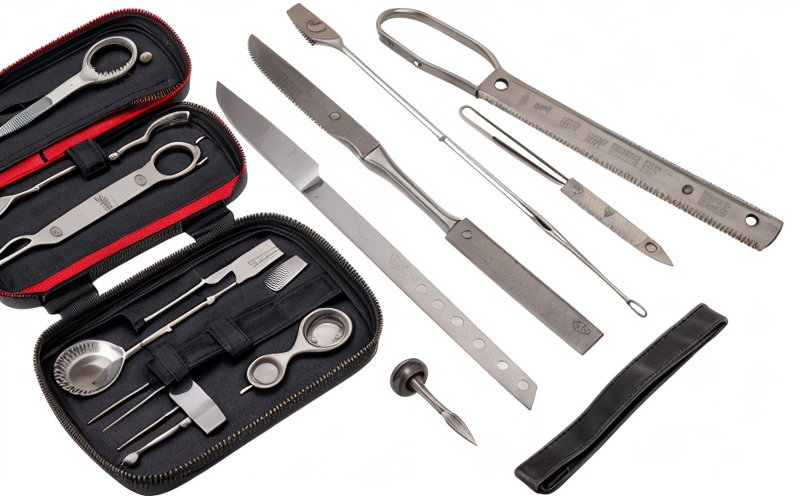Sharpness Testing of Surgical Knives and Scissors
The sharpness testing of surgical knives and scissors is a critical aspect of ensuring patient safety and optimal performance in medical procedures. A precise assessment of the blade edge ensures that instruments meet stringent quality standards, thereby minimizing the risk of adverse events during surgery.
Sharpened surgical blades are not only essential for cutting through tissue but also play a pivotal role in hemostasis (stopping bleeding) and achieving effective sutures. The sharpness testing process typically involves several steps that ensure consistent results and reliability across different instruments. This includes the use of standardized tools, precise measurement techniques, and adherence to relevant international standards.
During the testing process, blades are subjected to a series of evaluations aimed at assessing their ability to cut through various materials, such as synthetic sutures and human tissue. The primary goal is to determine whether the blades meet predetermined sharpness thresholds that are critical for safe surgical practices. This testing not only enhances patient outcomes but also supports compliance with regulatory requirements.
One of the key challenges in sharpness testing lies in ensuring repeatability and consistency across multiple samples and instruments. Advanced instrumentation, such as specialized cutting boards and digital measurement tools, helps to achieve this level of precision. The results are then analyzed using statistical methods to ensure that any variations fall within acceptable limits.
Accurate documentation is another critical component of the sharpness testing process. Reports generated from these tests provide detailed insights into the performance of each instrument. These reports are invaluable for quality managers and compliance officers, as they offer a clear picture of which instruments meet the required standards and which may need adjustment or replacement.
By leveraging advanced testing techniques and adhering to relevant international standards, laboratories can ensure that surgical knives and scissors maintain their sharpness over time, thereby supporting safe and effective medical procedures. This commitment to quality is essential for maintaining patient safety and optimizing healthcare outcomes.
Applied Standards
| Standard | Description | Purpose |
|---|---|---|
| ISO 13485:2016 | This international standard specifies the requirements for a quality management system for the design and development, production, installation and servicing of medical devices. | To ensure that manufacturers meet rigorous quality standards in the design and manufacturing of surgical instruments. |
| ASTM F2136-18 | This standard specifies a method for determining the sharpness of single-use surgical knives by measuring the force required to cut through a specified material. | To provide a standardized approach for assessing blade sharpness in a reproducible manner. |
| EN ISO 9001:2015 | This standard specifies the requirements for a quality management system that enables organizations to enhance customer satisfaction through the effective application of a systematic approach to quality assurance. | To ensure consistent and reliable quality in all aspects of medical device production, including sharpness testing. |
| IEC 60601-2-7:2013 | This standard provides recommendations for the electrical safety requirements of medical electrical equipment and systems used in hospitals. | To ensure that surgical instruments are safe to use, particularly with respect to electrical components if applicable. |
Scope and Methodology
The scope of sharpness testing for surgical knives and scissors encompasses the entire lifecycle of these instruments, from initial manufacturing to post-use evaluation. The methodology employed in this testing ensures that each instrument is evaluated consistently against established standards.
At the outset, blades are carefully prepared by removing any burrs or imperfections through a series of mechanical grinding processes. This preparation step is crucial for ensuring that only the actual cutting edge of the blade is tested. Once the blades are ready, they undergo evaluation using specialized cutting boards designed to simulate human tissue. These cutting boards are made from materials with properties similar to those found in surgical settings.
The testing process involves measuring the force required to cut through the material placed on the board. This measurement provides a quantitative assessment of blade sharpness. Higher values indicate less sharp blades, while lower values suggest sharper instruments. The results are recorded and analyzed using statistical methods to ensure that any variations fall within acceptable limits.
Following testing, detailed reports are generated for each instrument, highlighting its performance metrics. These reports serve as a crucial tool for quality managers and compliance officers in making informed decisions regarding the suitability of surgical knives and scissors for use in medical procedures. By adhering to these rigorous testing protocols, laboratories can ensure that only the highest quality instruments reach healthcare providers.
The methodology also includes regular calibration of testing equipment and periodic audits to maintain accuracy and reliability. This commitment to precision is essential for maintaining trust in the results produced by the laboratory.
Use Cases and Application Examples
The sharpness testing of surgical knives and scissors plays a vital role in various aspects of medical practice, from routine surgeries to emergency interventions. In elective procedures, ensuring that blades are at their optimal sharpness can enhance the efficiency and accuracy of the surgeon's work, leading to better outcomes for patients.
In emergency settings where time is of the essence, reliable and precise blade edges are crucial for rapid and effective intervention. This ensures that healthcare providers have the tools they need to perform life-saving procedures with confidence.
For surgical teams conducting training sessions or simulations, sharp blades provide a realistic training environment that closely mirrors actual operating conditions. This helps to prepare medical professionals for the challenges they may face in real-world scenarios.
The results of sharpness testing also inform decisions regarding instrument maintenance and replacement. By identifying instruments that no longer meet performance standards, healthcare facilities can ensure that all surgical tools are up-to-date and reliable.
In addition to routine evaluations, post-use assessments allow for the identification of any potential issues with blades after extended use or exposure to various materials. This feedback loop is essential for continuous improvement in both instrument design and manufacturing processes.





